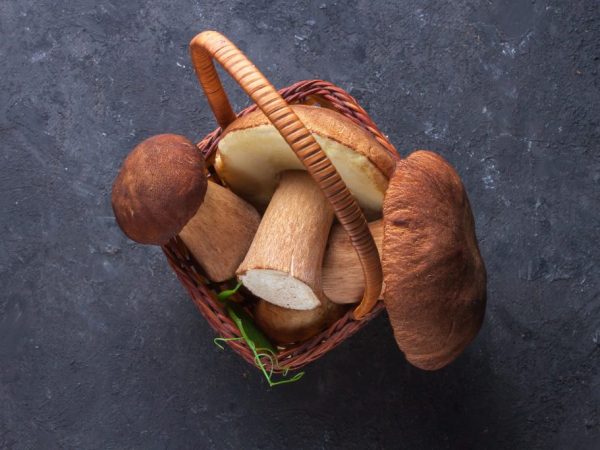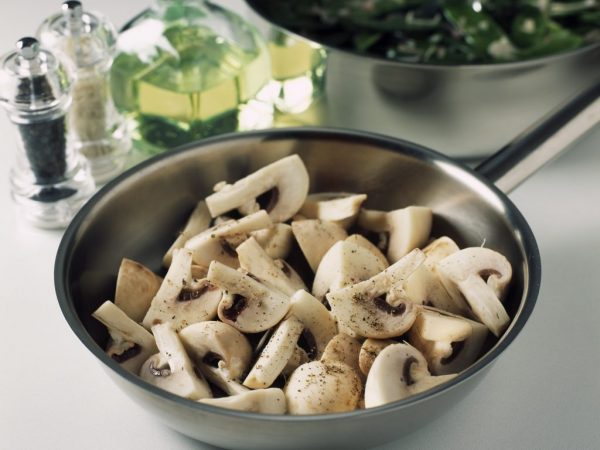Mushroom processing
The first place after harvesting is the processing of mushrooms. There is no need to hesitate with the process, because the product quickly deteriorates. If it is not possible to process the crop immediately after arriving from the forest, it is allowed to postpone work for only a few hours. To properly prepare mushrooms for use, you need to study certain rules.

Mushroom processing
Mechanical restoration
First, the harvested crop is carefully examined. If there are unfamiliar specimens that are in doubt, it is better to throw them away. Fruit bodies are not consumed if they:
- wormy;
- rotten;
- with mold;
- with mucus;
- damaged.
Sorting
Mechanical processing is carried out regardless of whether the mushrooms are to be used immediately, fresh or intended for canning. They are sorted by type and size because they are prepared in different ways and also differ in taste. Only medium-sized fruiting bodies are suitable for harvesting. Mushrooms are divided into those that are fried immediately, and those that require preliminary boiling.
Cleaning
It is worth getting rid of debris and small insects brought from the forest along with the harvest. To do this, use a soft brush or rag. Fruit bodies can be processed with a knife. If the product is to be dried, fried, baked, then it is not washed.
Irina Selyutina (Biologist):
To easily remove the film from the caps from butter and russula, you can hold them for 1-2 minutes in boiling water, then discard in a colander and rinse with cold water. You can simply grab it along the edge with a knife and remove it by moving your hand from the edges of the cap to the center. We clean until the surface turns white.
Then we separate the leg and make sure that there are no moves of mushroom worms in it and in the cap. If the lesion is large, discard the mushroom. If the defeat looks small, we cut the leg and cap into separate pieces and look again. We leave only the "clean" pieces. We do not remove the skin from the cap of boletus, white and moss mushrooms, but immediately clean the fruit body of forest debris and again check for worminess and cut it into pieces. Legs can be on wheels 1-1.5 cm thick, hats into equal-sized segments - halves, quarters.
Areas of fruit bodies damaged by pests are carefully cut out with a knife. All darkening and damage is removed. In old tubular mushrooms, the inner (lower) part of the cap is removed - the tubular hymenophore.
Washing
You need to process mushrooms with cold water. Immediately after this, they wait for the excess liquid to drain from the fruit bodies. Longer rinsing is required for species with an uneven surface. These include morels, stitches, etc. Sand adheres to the folded surface of the caps of these specimens, which needs to be washed. If the fruiting bodies are intended for drying or frying, such manipulations are not performed.
Soaking
Conditionally edible species require an increase in taste.
This is achieved by immersing mushrooms in salted water for several hours or a day.The liquid is periodically changed to fresh. For this, a low and wide vessel is selected; basins or bowls are best suited for these purposes. After that, the bitterness will go away. Dry fruit bodies are also soaked. This helps restore moisture. Experienced mushroom pickers recommend cutting the milk mushrooms into slices before soaking - it will be better to leave the bitterness from the fruit bodies. By the way. It is not recommended to use aluminum or stainless utensils to soak the mushrooms, in order to avoid the occurrence of chemical reactions between the surface of the container and the juice that is released (even if mixed with water).
Slicing
Large specimens are divided into parts. To make the dish taste good, the leg is cut into circles across the fibers. The hats are divided into equal parts. For canning, small fruiting bodies are used entirely.
Heat treatment

Heat treatment eliminates mushroom toxicity
The purpose of the process is to eliminate the bitterness or toxicity of some specimens. The rules for processing conditionally edible mushrooms provide for the mandatory implementation of the following manipulations.
Boiling
The mushrooms are boiled for 15-30 minutes. Fruit bodies are boiled in a large amount of water, but after that they lose a certain part of the nutrients. The smell becomes weaker, taste changes, so if possible, you should skip this process. Without heat treatment, the following types are used:
- White mushrooms;
- chanterelles;
- Champignon;
- summer and autumn mushrooms;
- most russules, etc.
Many species become viscous after boiling. In some fruiting bodies, only the legs have this feature. They are cut off from honey agarics, leaving only the hats.
During cooking, be sure to remove the foam that appears from the surface.
Boiling
To carry out the heat treatment of mushrooms, proceed according to the following recommendations:
- pour cold salted water so that it covers the mushrooms;
- bring to a boil and immediately remove from heat;
- leave in the broth until it cools down or poured over with cold water.
Squeezing fruiting bodies is prohibited. Otherwise, it will lead to the loss of many nutrients.
Blanching
With the help of scalding, they achieve the preservation of the integrity and elasticity of the specimens.
The method is suitable for russula with large flat caps, saffron milk caps, autumn oil. The essence of the technological process consists in the following actions:
- washed mushrooms are placed in a colander;
- doused with boiling water or dipped in boiling water or placed in a steam bath for a few minutes.
Processing recommendations
The basic rules for processing mushrooms are almost the same. But some differences still exist, it depends on the type:
- Butterlets: they must not be washed before cleaning, otherwise they will become slippery. It is worth removing the film from the cap. Fruit bodies are soaked in salt water for half an hour.
- Honey mushrooms: they are cleaned in lukewarm water unless drying is planned. Remove dirt with a toothbrush or cloth.
- Ryzhiki: fruiting bodies are wiped with a rag, washed under running water, the leg is cut.
- White mushrooms: cleaning is done with a knife. Wipe gently with a towel before drying. Cooking involves soaking for 15 minutes, after which the fruiting bodies are washed with a non-hard sponge.
- Oyster mushrooms: they are undemanding to cleaning. The darkening is removed, the uneven edges are cut out, the legs are cut off.
- Champignon: it is worth wiping them with a damp sponge and trimming the leg (refresh the cut).
- Boletus: the scales covering the leg are removed from them.
- Milk mushrooms: all collected specimens are soaked for a day, constantly changing the water. After that, they are thoroughly washed with a sponge (for black mushrooms, you can take a knife).
- Chanterelles: gently remove dirt from the records. The hats are wiped with a damp cloth. Soak for 10 minutes.
Conclusion
Processing of fresh mushrooms must be done quickly and efficiently.They are stored unprocessed for a maximum of 8 hours, but at the same time they are placed in a cool place. A refrigerator is most suitable for this.
If the fruit bodies are not cleaned immediately, pests will move from wormy specimens to clean ones. You can get rid of them by soaking in cold salted water.



